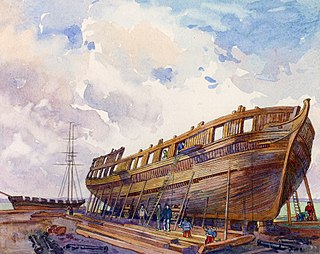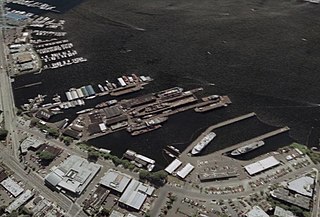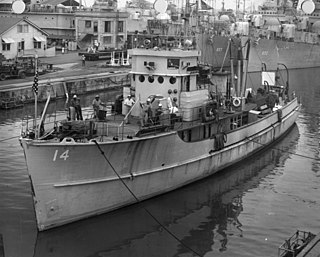
A shipyard, also called a dockyard or boatyard, is a place where ships are built and repaired. These can be yachts, military vessels, cruise liners or other cargo or passenger ships. Compared to shipyards, which are sometimes more involved with original construction, dockyards are sometimes more linked with maintenance and basing activities. The terms are routinely used interchangeably, in part because the evolution of dockyards and shipyards has often caused them to change or merge roles.

Vigor Shipyards is the current entity operating the former Todd Shipyards after its acquisition in 2011. Todd Shipyards was founded in 1916, which owned and operated shipyards on the West Coast of the United States, East Coast of the United States and the Gulf. Todd Shipyards were a major part of the Emergency Shipbuilding Program for World War II.

Fore River Shipyard was a shipyard owned by General Dynamics Corporation located on Weymouth Fore River in Braintree and Quincy, Massachusetts. It began operations in 1883 in Braintree, and moved to its final location on Quincy Point in 1901. In 1913, it was purchased by Bethlehem Steel, and later transferred to Bethlehem Shipbuilding Corporation. It was sold to General Dynamics in 1963, and closed in 1986. During its operation, yardworkers constructed hundreds of ships, for both military and civilian clients.
Bathurst Street Wharf was a series of shipyards located in Toronto, Ontario, Canada, between Bathurst Street and Spadina Avenue along Lake Shore Boulevard West.
Toronto Drydock Company is a shipbuilding repair company in Canada and the name of two shipbuilders in the 19th and 20th centuries respectively.

The Naval Shipyards were naval shipbuilding facilities used by the Provincial Marine and the Royal Navy in York, Upper Canada. The naval shipyards were ordered by the Lieutenant Governor of Upper Canada John Graves Simcoe in 1793, and were opened in 1798.

Lake Union Dry Dock Company is a full-service shipyard that specializes in vessel repair and conversions located in Seattle, Washington. Drydocking vessels up to 6,000 tonnes, , Lake Union Dry Dock Company repairs factory trawlers, fishing vessels, Coast Guard Cutters and buoy tenders, tugboats, research vessels, ferries, mega-yachts, barges, and houseboats.
Puget Sound Bridge and Dredging Company was a major shipbuilding and construction company, located in Seattle, Washington, on the southwestern corner of Harbor Island, an artificial island in Elliott Bay. The Bridge and Dredging Company created the island, completing its construction in 1909. It established itself in 1898 and engaged in construction projects around the United States and shipbuilding for the U.S. Navy during and after World War II. During the war it also operated under the name Associated Shipbuilders in a joint venture with the nearby Lake Union Dry Dock Company. In 1959 Lockheed purchased the shipyard and it became the Lockheed Shipbuilding and Construction Company. The Yard was permanently closed in 1987.

Burrard Dry Dock Ltd. was a Canadian shipbuilding company headquartered in North Vancouver, British Columbia. Together with neighbouring North Van Ship Repair and Yarrows Ltd. of Esquimalt, which were both later purchased by the company, Burrard built and refitted over 450 ships, including many warships for the Royal Navy and Royal Canadian Navy during the First and Second World Wars.

The Emergency Shipbuilding Program was a United States government effort to quickly build simple cargo ships to carry troops and materiel to allies and foreign theatres during World War II. Run by the U.S. Maritime Commission, the program built almost 6,000 ships.

General Engineering & Dry Dock Company was a shipbuilding and ship repair company in Alameda, California that was active from the 1920s through the 1940s. The company built ships for the Southern Pacific Railroad and the United States Coast Guard in the late 1920s and early 1930s and took part in the World War II shipbuilding boom, making diesel-propelled steel hulled auxiliaries for the United States Navy, primarily oceangoing minesweepers.
Henry B. Nevins Incorporated was wooden-hull yacht builder in City Island, New York founded in 1907 by Henry B. Nevins. Nevins was a master yacht builder and author on vessel construction who apprenticed at the island's Charles L. Seabury & Company. Later he purchased the nearby Byles Yard to increase his company's acreage. Henry B. Nevins Inc. built custom sail and motor yachts and racing craft for affluent clients, but also small tugs and barges for commercial customers. Run by a perfectionist, Nevins' company seasoned its own lumber, designed and machined its own fittings, made its own glue, and balanced spars by weighing shavings. As a result, Nevins built more cup-winning yachts than anyone else in the industry.

The Astoria–Megler ferry, also called the Astoria–McGowan ferry and the Astoria–North Beach ferry, ran across the Columbia River between Astoria, Oregon, and two ferry docks near the present small community of Megler, Washington, from 1921 to 1966.
Morton Engineering and Dry Dock Company was a shipbuilding company from Quebec City, Quebec. It was located in the Lower Town area of the city, along the Saint-Charles River. Founded in 1858, the shipyard stayed in operation until 1949, when it constructed its last ship. It built ships for the Royal Navy and Royal Canadian Navy during both world wars. In 1947, the company was renamed St. Lawrence Metal and Marine Works.

Hodgdon Yachts is a builder of yachts and specialized military vessels, based in East Boothbay, Maine. It is a family-run business that was founded in 1816—the oldest continuously operating family boatbuilder in the United States, antedating the Burger Boat Company in Wisconsin. Hodgdon Yachts is noted for building superyachts, both sail and power, using advanced composite materials and construction techniques. It's also noted for its ability to incorporate those advanced materials into traditional designs that employ modern electronic and mechanical marine systems. The company has several divisions—yachts, custom tenders, yacht interiors, yacht services and military composites with offices in Boothbay, Maine, Newport, Rhode Island and Monaco.

The Type V ship is a United States Maritime Commission (MARCOM) designation for World War II tugboats. Type V was used in World War II, Korean War, and the Vietnam War. Type V ships were used to move ships and barges. Type V tugboats were made of either steel or wood hulls. There were four types of tugboats ordered for World War II. The largest type V design was the sea worthy 186-foot (57 m) long steel hull, V4-M-A1. The V4-M-A1 design was used by a number of manufacturers; a total of 49 were built. A smaller steel hull tugboat was the 94-foot (29 m) V2-ME-A1; 26 were built. The largest wooden hull was the 148-foot (45 m) V3-S-AH2, of which 14 were built. The smaller wooden hull was the 58-foot (18 m) V2-M-AL1, which 35 were built. Most V2-M-AL1 tugboats were sent to the United Kingdom for the war efforts under the lend-lease act. The Type V tugs served across the globe during World War II including: Pacific War, European theatre, and in the United States. SS Farallon, and other Type V tugs, were used to help built Normandy ports, including Mulberry harbour, on D-Day, 6 June 1944, and made nine round trips to Normandy to deliver Phoenix breakwaters.

South Coast Shipyard was a shipbuilding company in Newport, California. To support the World War II demand for ships South Coast Shipyard built: minesweepers, Torpedo Boats, Submarine chasers, & Air-sea rescue boats. South Coast Shipyard was opened in 1938 by Walton Hubbard. After World War II the shipyard continued to build ships for the US Navy till 1955. The shipyard was located at 2300 Newport Boulevard, Newport, California. The shipyard closed in 1963.

Splinter fleet or Splinter navy was a nickname given to the United States wooden boats used in World War II. The boats served in many different roles during the war. These boats were built in small boatyards on the West coast and East coast, Great Lakes and the Gulf of Mexico. They could be built quickly, in just 60 to 120 days. Most of the boats were built by boatyards that already had the tools and knowledge from building yachts, sailboats and motor boats. Many were built by craftsmen in family-owned small businesses. Under the Emergency Shipbuilding Program and War Shipping Administration contracts went out to over fifty boatyards across the country. The boats were built for the US Navy, the United States Army Air Forces, United States Coast Guard, and US Army. Some of the wooden boats went to Allied nations on the Lend-Lease program.

Weaver Shipyards, also called Weaver Brothers Shipyards was a shipyard in Orange, Texas on the Sabine River. The shipyard opened in 1897. The shipyard was founded by Joe Weaver and his son as Joseph Weaver and Son Shipyard. Joe Weaver was L.E. Weaver, known as Ed Weaver. In 1898 Levingston Shipbuilding Company founder, George Levingston purchased major shares of Joseph Weaver and Son Shipyard. Weaver Shipyard's early work was the construction work for Galveston Navigation District building barges. The yard was also active in building and repairing tugboats. In 1930 Joseph Weaver died and a new family partnership was made, L.E. Weaver and his son. Ed Weaver's son was L.A. Weaver. In 1941 Ed Weaver died and L.A. Weaver changed the shipyard to Weaver Shipyards. Weaver Shipyards became a partnership of several a Weaver family members.
The George F. Rodgers Shipbuilding Company was a shipbuilder located in Astoria, Oregon.
























